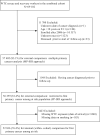Cancer Incidence in World Trade Center Rescue and Recovery Workers: 14 Years of Follow-Up
- PMID: 34498043
- PMCID: PMC8826586
- DOI: 10.1093/jnci/djab165
Cancer Incidence in World Trade Center Rescue and Recovery Workers: 14 Years of Follow-Up
Abstract
Background: Statistically significantly increased cancer incidence has been reported from 3 cohorts of World Trade Center (WTC) disaster rescue and recovery workers. We pooled data across these cohorts to address ongoing public concerns regarding cancer risk 14 years after WTC exposure.
Methods: From a combined deduplicated cohort of 69 102 WTC rescue and recovery workers, a sample of 57 402 workers enrolled before 2009 and followed through 2015 was studied. Invasive cancers diagnosed in 2002-2015 were identified from 13 state cancer registries. Standardized incidence ratios (SIRs) were used to assess cancer incidence. Adjusted hazard ratios (aHRs) were estimated from Cox regression to examine associations between WTC exposures and cancer risk.
Results: Of the 3611 incident cancers identified, 3236 were reported as first-time primary (FP) cancers, with an accumulated 649 724 and 624 620 person-years of follow-up, respectively. Incidence for combined FP cancers was below expectation (SIR = 0.96, 95% confidence interval [CI] = 0.93 to 0.99). Statistically significantly elevated SIRs were observed for melanoma-skin (SIR = 1.43, 95% CI = 1.24 to 1.64), prostate (SIR = 1.19, 95% CI = 1.11 to 1.26), thyroid (SIR = 1.81, 95% CI = 1.57 to 2.09), and tonsil (SIR = 1.40, 95% CI = 1.00 to 1.91) cancer. Those arriving on September 11 had statistically significantly higher aHRs than those arriving after September 17, 2001, for prostate (aHR = 1.61, 95% CI = 1.33 to 1.95) and thyroid (aHR = 1.77, 95% CI = 1.11 to 2.81) cancers, with a statistically significant exposure-response trend for both.
Conclusions: In the largest cohort of 9/11 rescue and recovery workers ever studied, overall cancer incidence was lower than expected, and intensity of WTC exposure was associated with increased risk for specific cancer sites, demonstrating the value of long-term follow-up studies after environmental disasters.
© The Author(s) 2022. Published by Oxford University Press.
Figures


Comment in
-
World Trade Center Rescue and Recovery Workers: Cancer Increases Are Beginning to Emerge.J Natl Cancer Inst. 2022 Feb 7;114(2):172-173. doi: 10.1093/jnci/djab164. J Natl Cancer Inst. 2022. PMID: 34498080 Free PMC article. No abstract available.
References
-
- CDC, NIOSH. World Trade Center chemicals of potential concern and selected other chemical agents; summary of cancer classifications by the National Toxicology Program and International Agency for Research on Cancer. 2012. https://www.cdc.gov/niosh/docs/2012-115/pdfs/2012-115.pdf. Accessed August 26, 2021.
-
- Connick KD, Enright P, L Middendorf PJ, et al.First Periodic Review of Scientific and Medical Evidence Related to Cancer for the World Trade Center Health Program. Columbia, DC: National Institute for Occupational Safety and Health; 2011.
-
- Yip J, Webber MP, Zeig-Owens R, et al.FDNY and 9/11: clinical services and health outcomes in World Trade Center-exposed firefighters and EMS workers from 2001 to 2016. Am J Ind Med. 2016;59(9):695–708. - PubMed
Publication types
MeSH terms
Grants and funding
LinkOut - more resources
Full Text Sources
Medical

